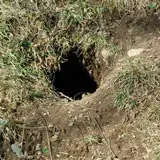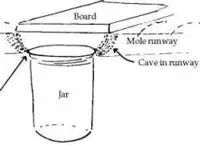
The least compelling reason for getting rid of moles is that they leave a lawn in shambles with their molehills and their tunnels, or “runways” as they’re called in the pest control industry. A far better reason to get rid of moles are the concerns of gardeners and the damage a mole can do to a garden, depending on the species and how hungry they are. The thing is, a gardener (or the person in charge of lawn maintenance) has to decide which is more important, getting rid of grubs and other garden pests or getting rid of moles. Moles are under your lawn and in your garden for one reason and one reason alone: there is food in that there dirt, and lots of it.
Moles love grubs and/or beetle larvae. Earthworms are yummy, too. But mostly they’re there for the grubs. So, obviously, if you have a problem with grubs, it might be a good idea to let the moles live. Moles don’t do that much damage to the vegetation, really. Their jaws aren’t strong like a groundhog’s. If, however, you have a supermole on your hands, then here are some ways to certainly get rid of moles.
Identifying Moles
Getting rid of moles takes a bit of patience. Because moles are fickle creatures who often abandon their tunnels, it’s difficult to detect active mole tunnels. If you can’t find an active mole tunnel than you should consider the possibility that it is not a mole you’re after. A lot of people mistake burrows dug by groundhogs or gophers for molehills. Below are two pictures: one is a molehill and the other is a gopher burrow. Note the conical structure of the molehill.

Molehill

Gopher Burrow
Best Ways to Get Rid of Moles
Find Active Mole Tunnels
Detecting which mole tunnels are most active is your first step to get rid of moles. Of all the mole species, there are just two ways to detect whether or not mole tunnels are active. The first way (for moles that build shallow tunnels) is to find a straight runway and stomp it in with your foot. If the mole is active in that area they will repair the tunnel in no less than a day. The second way to find an active mole runway is to poke around with a stick around the area where there are a large number of molehills. Once you’ve found a spot where the earth gives way, you’ve found an active tunnel.

Set Live Traps
Once you’ve found an active tunnel you can get rid of the mole with a pit trap. The pit trap technique is something I stole from Common-sense Pest Control, by William Olkowski. Dig your way into the mole tunnel, being careful not to cause too much damage. Then, excavate enough earth to fit either a large jar or coffee can into the tunnel in such a way that the can is level with the bottom of the tunnel. Cover the tunnel with whatever will best keep light out, and check the trap once or twice a day. If you catch the mole, you can release it somewhere far away and live happily knowing you didn’t kill the cute littler feller. If, however, you are a more vengeful gardener…well, accidents happen to moles.
Set Lethal Traps
So you have an active mole tunnel in your sights, but catch and release isn’t the way you want to get rid of moles. Well, luckily for you there are a number of very effective mole killing traps on the market today. You have a choice between whether you want to chop the mole in half, choke the mole to death, or impale the mole like a little mole-kebab. Victor® and Nash® are perhaps two of the most popular brands of mole traps on the market. There is quite the selection of mole traps online these days. We’d suggest starting with the JT Eaton 490 Mole Trap model sold by Amazon, it’s a decent price and is quite medieval looking.
Flood Them Out
If you’re not into the whole trapping thing as a way to get rid of moles, you might want to try flooding the moles out. There are a lot of people who say that flooding moles out of their tunnels doesn’t work, and they might be right about a particularly persistent mole. The key to the flooding method is to find a straight active tunnel amidst a cluster of molehills. Simply insert the hose into the tunnel, wait until there is a sufficient amount of flooding, and see if you can’t catch the little bugger when he tries to escape.
Build Barriers
If you don’t think trapping and flooding are for you, then it’s time to start building barriers to get rid of moles. Building barriers won’t necessarily get rid of moles, but it will help to keep moles out of particular areas, such as a garden. There are two possibilities for mole barriers: you can get some fencing with a smaller mesh, or you can get something like concrete or gravel. It doesn’t matter what you decide to lay down as a barrier, so long as it is at least 2 feet beneath the earth’s surface. This isn’t a fail-safe method, but it is one of the least lethal methods of mole control.
How to Kill Moles
Killing moles isn’t hard. Their skulls are so fragile that even a slap on the ground with a shovel will kill a mole, or at least stun it.
As I’ve mentioned previously in this article, the most effective way to get rid of moles is to set mole traps that kill moles, rather than a live trap. Live traps and/or pit traps are certainly far more humane than a lethal mole trap, but often times live trapping is ineffective because moles detect a large amount of damage to the tunnel and suspect the presence of a predator. Thus, the mole tunnel is abandoned, and another is burrowed, giving your lawn yet another unwanted geological feature. Lethal mole traps are superior to live traps because they usually require less damage to the mole tunnel to be set.
Effective use of lethal mole traps requires following quite carefully the instructions that come with whichever trap you choose. I’ve read a lot of people are quite pleased with Victor’s® spring-driven spike mole trap, but the Nash® “choker” mole trap leaves you with much less of a mess to deal with once you’ve killed the mole.
Home > Pest Control > Animals > Best Ways to Get Rid of Moles Best Ways to Get Rid of Moles Originally Published on June 8, 2007 Modified on January 6, 2017 The least compelling reason for getting rid of moles is that they leave a lawn in shambles with their molehills and their tunnels, or “runways” as they’re called in the pest control industry. A far better reason to get rid of moles are the concerns of gardeners and the damage a mole can do to a garden, depending on the species and how hungry they are. The thing is, a gardener (or the person in charge of lawn maintenance) has to decide which is more important, getting rid of grubs and other garden pests or getting rid of moles. Moles are under your lawn and in your garden for one reason and one reason alone: there is food in that there dirt, and lots of it.Moles love grubs and/or beetle larvae. Earthworms are yummy, too. But mostly they’re there for the grubs. So, obviously, if you have a problem with grubs, it might be a good idea to let the moles live. Moles don’t do that much damage to the vegetation, really. Their jaws aren’t strong like a groundhog’s. If, however, you have a supermole on your hands, then here are some ways to certainly get rid of moles. Identifying MolesHere is a mole hillMole Hillhere is a gopher holeGopher BurrowGetting rid of moles takes a bit of patience. Because moles are fickle creatures who often abandon their tunnels, it’s difficult to detect active mole tunnels. If you can’t find an active mole tunnel than you should consider the possibility that it is not a mole you’re after. A lot of people mistake burrows dug by groundhogs or gophers for molehills. Below are two pictures: one is a molehill and the other is a gopher burrow. Note the conical structure of the molehill. Best Ways to Get Rid of Molesmole tunnels visible from the surfaceDetecting which mole tunnels are most active is your first step to get rid of moles. Of all the mole species, there are just two ways to detect whether or not mole tunnels are active. The first way (for moles that build shallow tunnels) is to find a straight runway and stomp it in with your foot. If the mole is active in that area they will repair the tunnel in no less than a day. The second way to find an active mole runway is to poke around with a stick around the area where there are a large number of molehills. Once you’ve found a spot where the earth gives way, you’ve found an active tunnel. diagram for a mole trapOnce you’ve found an active tunnel you can get rid of the mole with a pit trap. The pit trap technique is something I stole from Common-sense Pest Control, by William Olkowski. Dig your way into the mole tunnel, being careful not to cause too much damage. Then, excavate enough earth to fit either a large jar or coffee can into the tunnel in such a way that the can is level with the bottom of the tunnel. Cover the tunnel with whatever will best keep light out, and check the trap once or twice a day. If you catch the mole, you can release it somewhere far away and live happily knowing you didn’t kill the cute littler feller. If, however, you are a more vengeful gardener…well, accidents happen to moles.mole killing trapSo you have an active mole tunnel in your sights, but catch and release isn’t the way you want to get rid of moles. Well, luckily for you there are a number of very effective mole killing traps on the market today. You have a choice between whether you want to chop the mole in half, choke the mole to death, or impale the mole like a little mole-kebab. Victor® and Nash® are perhaps two of the most popular brands of mole traps on the market. There is quite the selection of mole traps online these days. We’d suggest starting with the JT Eaton 490 Mole Trap model sold by Amazon, it’s a decent price and is quite medieval looking.If you’re not into the whole trapping thing as a way to get rid of moles, you might want to try flooding the moles out. There are a lot of people who say that flooding moles out of their tunnels doesn’t work, and they might be right about a particularly persistent mole. The key to the flooding method is to find a straight active tunnel amidst a cluster of molehills. Simply insert the hose into the tunnel, wait until there is a sufficient amount of flooding, and see if you can’t catch the little bugger when he tries to escape.diagram of a mole barrierIf you don’t think trapping and flooding are for you, then it’s time to start building barriers to get rid of moles. Building barriers won’t necessarily get rid of moles, but it will help to keep moles out of particular areas, such as a garden. There are two possibilities for mole barriers: you can get some fencing with a smaller mesh, or you can get something like concrete or gravel. It doesn’t matter what you decide to lay down as a barrier, so long as it is at least 2 feet beneath the earth’s surface. This isn’t a fail-safe method, but it is one of the least lethal methods of mole control. How to Kill MolesKilling moles isn’t hard. Their skulls are so fragile that even a slap on the ground with a shovel will kill a mole, or at least stun it.As I’ve mentioned previously in this article, the most effective way to get rid of moles is to set mole traps that kill moles, rather than a live trap. Live traps and/or pit traps are certainly far more humane than a lethal mole trap, but often times live trapping is ineffective because moles detect a large amount of damage to the tunnel and suspect the presence of a predator. Thus, the mole tunnel is abandoned, and another is burrowed, giving your lawn yet another unwanted geological feature. Lethal mole traps are superior to live traps because they usually require less damage to the mole tunnel to be set.Effective use of lethal mole traps requires following quite carefully the instructions that come with whichever trap you choose. I’ve read a lot of people are quite pleased with Victor’s® spring-driven spike mole trap, but the Nash® “choker” mole trap leaves you with much less of a mess to deal with once you’ve killed the mole. Natural Mole Control
Get Rid of Japanese Beetles
They’re more than just your average garden pest; they’re also quite compatible with the mole’s palette. Moles love Japanese beetle larvae, or grubs as we call them, more than anything in the whole world—more than the cookie monster loves cookies. If you want to get rid of moles, you might want to consider getting rid of the Japanese beetles on your property. You can check out things like the Japanese Beetle Trap at Amazon to help with this.
Use Gravel Barriers
The gravel barrier is actually a very effective mole deterrent; though it requires a lot of work, the results should please the gardener who has had mole problems in the past. What you’ll want to do is dig a trench approximately 8-12 inches wide and 24-36 inches deep in a perimeter around the area you wish to protect. Then all you have to do is fill the trench with gravel and cover it back up. The chances of a mole trying to get over the barrier by foot are marginal. Because moles are adverse to very dense earth, you might want to consider using clay instead of gravel to fill the mole barrier.